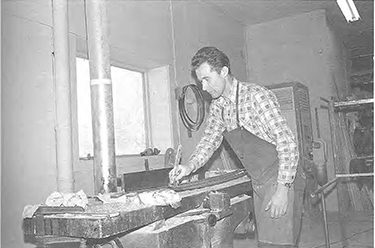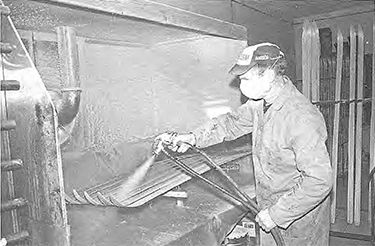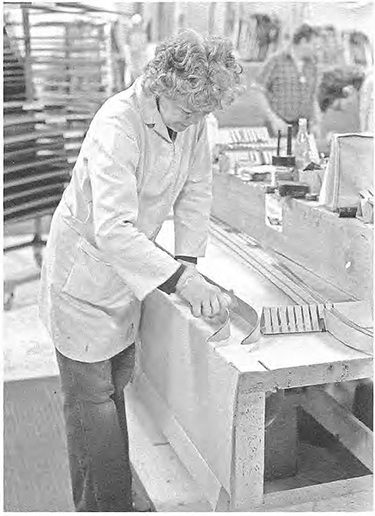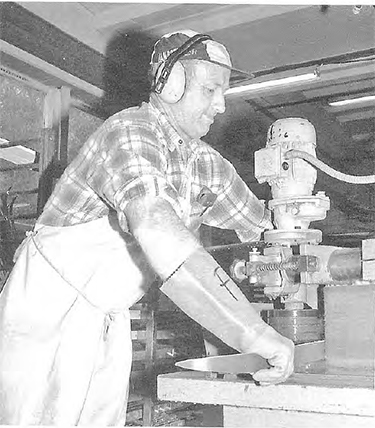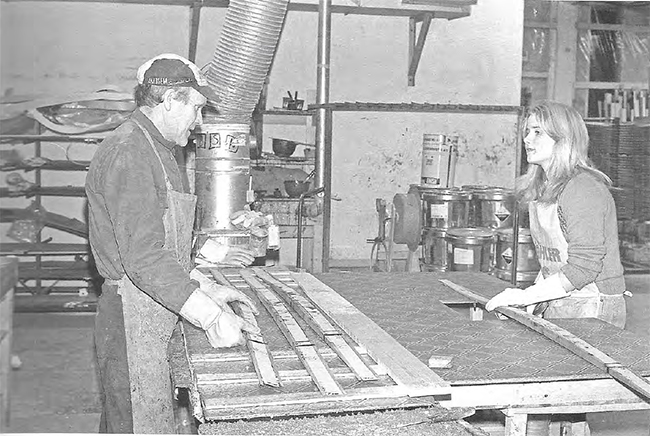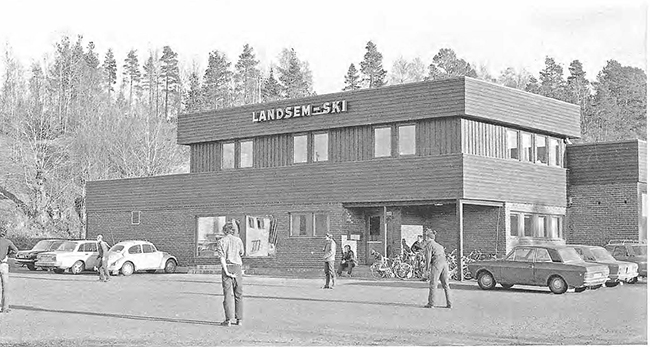
"Dedicated to the preservation and enjoyment of skiing with wooden skis"
Memories from the Landsem Ski Factory
in Rindal, Norway
By Edgar Kattem, translated by Greg Fangel
We express our hearfelt thanks to Ole Foseide from Rindal, Norway for leading us to Author Edgar Kattem, who gave us permission to share this wonderful piece of history . The original story was written in Norwegian and translated into English. All photos and text from this point forward © copyright 2021 by Edgar Kattem......Greg |
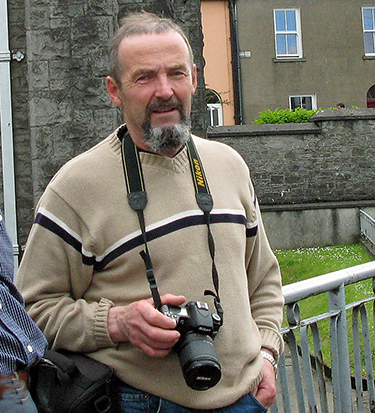 | In the winter of 2019, I started something I have been thinking about for a long time - writing down the memories I have from my first famous workplace. It was Landsem Ski Factory. I had work there from November 1968 until April 1981. I have flipped through old diaries and my memory to get together this "work". It was a fairly long period of great change at the factory, both in staffing and the methods of making skis, from "old-fashioned" production of wooden skis to the production of skis made of fiberglass, plastic and other new materials. It is not meant to be a story about the Landsem Ski factory; others can write about this. This story is about my memories from this time. I remember my work and workmates at a good workplace, based on my memory and writings in my diaries. |
My very first meeting with Landsem Ski Factory was from a school trip in the 1950s. We, who were students at Storli school, had a school trip which consisted of a trip around Rindal. Among the places we got to see were Rindal Dairy - and Landsem Ski Factory. I remember the tour of the ski factory. We were inside the paint room and there was a guy spraying lacquer on skis. I think it was Arne Børset. I remember the strong smell of lacquer that was there, of the spraying and the skis laying out to dry. Later, in the 1960s, we often went past the ski factory when we went up to Rindal Assembly House to have physical exercise or other activities. There we saw workers standing and cutting materials outside, before they carried them into the factory. Among the workers were Johan Røen and Odd Børset, and we the students talked to them. They were nice guys to talk to. Of course, I did not know then, that all these guys would be some of my good co-workers later. They - and the smell of lacquer and paint - would follow me for many years. First Stage
I was happy, but at the same time, there was a thought that bothered me a little. Just as this happened, my father and I drove home from the region by Langvatnet. We drove a load of firewood beyond Langvasskjöl with a half-tracked tractor. A little cold, but otherwise really good work. And as I drove up the village I had a thought in the back of my mind: I thought of my father, who now had to complete the drive alone! Together with Even, I had a quick tour of the factory, which was then fairly new. The review of the factory showed me the building as it was then. Farthest to the east was the material warehouse. Then came the gluing room and the material drying room, the gluing room on the south side and the material drying room on the north side. Then came the machinery hall, which covered the entire width of the building. The next department was the so-called "handicraft room", and from there was the entrance to the lacquering room, and to the room where there was packing and storage. Farthest to the west end was the cloakroom, dining room and office. The work started all day on Monday, November 25. After a tour of the factory and production area, I was placed in the old glueing room the first work week. I was together with Olaf Røen, Ola Honnstad, Jostein Røen and Ola Romundstad Sr., who were there most of the time. Usually, there were many who stopped by the work in the glue room. In the afternoon and evening, Reidar Helge was stationed there. It was Ola Honnstad, who was assigned to teach me the work there in the glueing room. And it was a bit of an instruction. He explained and demonstrated the workflow continuously for a half an hour. Afterwards, he talked about other things, so it was important to keep up with the lessons. But luckily, I picked it up after a quarter of the work day and learned to glue both wood blanks and skis. By the way, there was another work task that Ola Honnstad taught me a little later. It was the blending of glue. It was a rather unpopular task which Ola assigned in turns. The glue was a powder stored in paper sacks down in the cellar under the warehouse and packing area. The powder was light and very dusty when handled during mixing, so therefore it was not a popular task. The mixing of glue was the only work task at the ski factory where they used a face mask during the work. They hung such masks in the basement where the glue bags were stored. The glue was mixed in a typical ten liter plastic pail and Ola gave me a short and straightforward instruction when he sent me down to the basement for my first mixture of glue. I brought the bucket along with a simple "measuring stick" of wood. On this measuring stick he had cut a notch. Cold water had to be added in the bucket until it reached the notch on the stick. So there were six or seven measures of glue powder. The measuring scoop was an old water dipper without a shaft that laid on top of the glue bags. So it was just a matter of mixing everything up and carrying the glue bucket up to the glueing room. This glue required a hardener in order to dry. There were two types of hardener, yellow and blue. Hardener was applied to a surface, and then glue was applied to the surface that was to lie against it. The yellow hardener was used for gluing insert blocks and other things where it was quick to get the materials under pressure. The blue hardener was used for ski gluing and other things that required a little longer before the subject came under pressure. There was a pleasant working environment in the glueing room, pleasant guys to work with and a little less noise than in the machinery room. There were many fun episodes; I remember well Olaf Røen when he stood by the hydraulic glue press, where the skis were final glued. Olaf was careful in his work, and if he saw a small gap between the laminations on the skis after gluing, he was quick to put a piece of paper or two in the press before he put in the next ski. He had his own technique, had strips of paper in his mouth as he aimed, and tore the strips into pieces. Then he decided where the patches should be placed quickly before he put the pressure on the skis. Ola Honnstad claimed that Olaf looked like a flycatcher who was building a nest, standing with strips of paper between his lips. Not everyone agreed with this system of pieces of paper that Olaf had. The ski press was cleared then and all the papers were removed. And Olaf started from scratch with his "nest-building"! How many workers there were at the ski factory when I started, I do not remember exactly, but I will remember the very best of them. The boss himself was Even Landsem, and with him in the office and the administration he had both Johan and Inger. Ingolf Røen was the foreman and leader of most of the practical tasks. Then there were two pairs of brothers who were the very "eldest" in the workforce. It was Odd Børset and Arne Børset together with Johan Røen and Jostein Røen. These four were the first four to start working for Even. Odd Børset was "everything-possible-man", and had the job of operating the materials drying room. Brother Arne also did much of the work, such as lacquering and many other things. Johan Røen operated the milling machine. There he milled the width profile and the groove under the ski. Everything was old-fashioned using home-made milling templates. Johan often had Ola Honnstad with him as an assistant during this milling. Johan was also the one who had most of the work of repairing skis that were broken or damaged in other ways. Jostein Røen was in the glue room every other week, and the next week, he cut materials on the band saw.
Edvin Grytbakk worked inside the machine hall and operated the dimension planer. Jon Elshaug was alternate on the band saw and in the glue room. Peder Løset and Olav Bolme (Fjellset) were at the sanding wheel and sanded the edges on pre-glued skis. Olav Kirkholt operated a sander and finished the sanding of the back of the skis. Those were the workers I remember when I started at Landsem Ski. During the years there were many who came and went in the workforce at the factory. Some were there for many years and others stopped by for a shorter time. But one of them which was at the ski factory when I was there is weird to think about ... There's Jostein Røen. He was in place when I had my first working day at Landsem Ski. Long afterwards we met again. When I had my first working day at the planer at Rindalshytter (Rindals Cabins), Jostein was there . With that we were workmates again - thirty years later! After working for three weeks in the glueing room, I wanted to try working in the machinery room. Jostein Røen gave me instruction on the use of the large bandsaw, which was used to split raw materials. From there came the transition to more demanding and difficult work. At first, it was work that went beyond my experiences, and I struggled with getting into this work. I was on the verge of destroying the whole blade system on the saw when I split lots of hickory plank for the first time. There were situations which came up fast and I was not experienced and attentive enough. The blade system went hot, and there was thus little repair of the saw. It was a proper awakening and learning experience. Over the winter, work went on, with production of wooden skis using "old-fashioned" methods. I went on a tour between different work tasks at the factory. There was gluing, sawing and occasionally I was placed outside in the "handwork room". And often I stood by the planer and straightened up materials and the glued blocks that came from the glue presses. They had to be straight and flat before they could be splined onto other pieces. But one thing I wonder about in retrospect. It was evening shift for gluing skis, and parts of this shift we were alone at work. I was placed on the evening shift on the ski press without any other help. As little experience as I had, I wonder a little about it in retrospect. But I then had to continue, I said it went well, I believe. Tuesday of Easter week, April 1, 1969, was the last work day before a one year break. I was going into military service, after about four months of work at Landsem Ski Factory. Next Period But not many days after Easter, we got to come home. On Wednesday, April 1, early in the morning, we boarded busses, which drove us to Bordufoss airport. There we boarded a Hercules plane and headed south. After a stopover in Bodø we arrived in Værnes. There were buses ready to take us to Trondheim. And it fit so well that I could take the "Mørelinjen" (refers to the Møre bus line) home to Rindal. There I went and called home to my father who would come and get me. While I was in town, I called Even Landsem to ask him if he still had work for me. Even confirmed and said that I would meet up with him at the factory on Monday, April 6. It wsa great to get home and I was happy to get a job. Things had happened with ski production in Rindal in the course of the year I had been gone. A new ski factory had started up. It was Landsem Småski AS. They were in the industrial area in Bjerginn in Rindal, and they were to produce children's skis and short skis up to 180 cm - as far as I remember. Otherwise, most of it at Landsem Ski Factory was the same as I remembered it. There were no major changes which had happened during the time I had been gone. There were the same guys as I knew from before who were still there. The largest change was probably that Ingolf Røen had quit and had begun as leader of the new Landsem Småski factory. Inge Grøseth had started at the factory page last time I was there. And there was still production of wooden skis in a fairly traditional way. And Johan Røen still repaired fine wooden skis that were broken. And all broken skis should be repaired by next weekend! I myself did not wander around much in the workplace. I was in the glueing room, participated in material cutting and creation of material and glue blocks. But after a while, I was more and more stuck out in the "handwork room". There I worked side by side with Odd Erik Heggem. We had many a working day there together in the relatively quiet the room. So we told many stories to each other during many days and months of work together. I remember all the operations that were to make wooden skis according to the old fashioned way.Most were made from raw material to the finished product. The materials were spruce, birch, hickory, red beech, lignostone and balsa wood. The materials came by truck, and then the whole work force mobilized to bring the materials down from the truck. Then they were stacked up outside and checked over with an overall look. Ola Romundscad sr. had the task of bringing in the materials to be used at any given time. Then he cut the materials and made sure to stack them into the drying room. In the end, it was Odd Børset's task to measure the humidty level of the materials before they entered production. The materials were split up on a saw, or straightened on a planer and dimension planer for glue pieces. After gluing the said pieces were straightened on the planer, and then split up in pieces on the band saw. After a round through the dimensional planer, they were ready. Wooden skis consisted of three main parts: the sole, the inside, and the cap. The sole was best made of laminated hickory, with lignostone edges. There could be soles of birch on light skis with hickory or lignostone edges. Lignostone was a hard material made of compressed beech. The inside was mostly made of spruce with birch on the outer edges. The inside blocks were glued so that there were two pieces in each block. There should be the same material for both skis of a pair. On light skis, there were to laminations of balsa wood to keep the weight down as much as possible. The balsa wood was strange to work with being light and crazy. One had to be careful applying pressure when gluing balsa; one could simply compress the whole piece of wood. I cut a lot of balsa on the bandsaw and I still remember the inscription on the planks of wood: "Pore Orinoco Equador via Hamburg" The top layer of the ski had a laminated layer of birch. The core and the top were glued together in a small curvature, with tension, because it was planed and glued together for the finished ski. It was said that this glued finished tension in the insert was one of the "secrets" at Landsem Skifabrikk.
Quite a few work operations had to be done before the main parts were finished into skis. An important operation was dimension planing of the parts. Edvin Grytbakk was the person responsible for this and he planed both the top plate and bottom of the ski. The soles were planed on top of a template of hard wood. This to make the soles thinner in front than behind on the skis. It was to correct the failure in the skis; they should be softer in front of the binding than behind. The core was also planed on a template, one template for every length. To get the glued cores through the dimension planer the ends had to be slanted out so that they did not get stuck in the planer. This work was done manually on band saw. Arne Børsec often had this the job, and he was a master at the bandsaw. It was easy to cut off too much or too little. Arne worked quickly and accurately. I had sometimes this job itself and learned it well, but I never reached the level Arne had. The ends of the cores had to be sanded using the long sanding belt. The ends had to "go out to zero" for that there should be no gaps in the gluing at the end of the core. Peder Løset and Olav Bolme performed the manual sanding. Except for a few small, thin wedges that were made between the sole and the upper plate at the rear end of the ski, the parts were now finished and ready for gluing to skis. These little wedges were cut from the work at the band saw from the core. The birch wedges that were cut from the ends of the cap were taken care of and used in the back of skis. So therefore it was important to cut these small wedges of the right length and thickness - and the must not be defective. (This is where Arne was champion). Then the parts were glued together, and the next tasks were up for grabs. Very first operation was to roughly cut the ski tips before milling. These were done "freehand" on the band saw. Here again, Arne was the master. He put together two skis and cut quickly and perfectly. The others contented themselves to cut one ski at a time. After this, the next operation was to shape the skis. This job was done by Johan Røen, with assistance from Ola Honnstad. The equipment used was a typical, vertical-shaft shaper, something you would see in many carpenter shops. Using the machines at the factory, he milled the profile on the ski, with a side-cut, and then milled the backs on the ski and the hollow groove on the side, that was typical of Landsem skis. The groove was 25cm long under the binding area, on both sides of the skis. Sometimes, in this groove there was a special color: brown for touring skis, yellow for "Spesial" skis, and white for light skis. Finally, the groove was cut into the sole of the ski. Further treatment of sanding was next. The back of the ski was sanded by Olav Kirkholt. And then there was Peder Løset and Olav Bolme who did the other work with sanding of sides, top cap and sole on the large belt sander. Much was done "freehand", so there were many skilled craftsmen at the ski factory!
After a short time, I learned quite well to paint this stripe, to make a good brush on the stick and to draw the template that guides the brush. But nevertheless, the wood had to be scraped straight and clean with a ruler and metal scraper before it was finished. So that was a good deal of work on the skis, using the metal scraper there in the handwork room, and it is a tool that quickly becomes dull. The vast majority of sharpening occured using an emery disk, but Odd Erik and I filed our metal scrapers. And I will claim that we two had the sharpest metal scrapers even if it took longer to file than use the emery wheel. There were tur-langrenn skis that had to be milled specially on the back ends of the ski to accept aluminum fittings. (tail protectors) These fittings had to be locked by pinching the corners together at the end of the fitting. This was done with the help of an old pair of hoof pliers. The pliers had an ugly notch in the middle of the jaws. Odd Børset explained to me that this notch happened when they had to move machines and equipment from the factory up by Holt. Even Landsem cut off the rubber electrical cable to the planer, while the electricity was on. Even did not check if the plug was pulled out of the receptacle, and that was a proper conclusion. Even got a shock so he went down on his knees, and the hoof pliers had a properly burned notch in the mouth. Both the pliers and Even survived. The last operation in the handwork room was to stamp numbers on the skis. This was done manually with a loose digit stamp and a hammer. I have stamped numbers on several thousand pairs of Landsem skis. This task of stamping numbers with a stamp and a hammer might seem like an easy task, but it was something to be learned. It took some time for the distance between the numbers to be even. And then there were the two strips of red beech in the top plate as I mentioned before. The beech was harder than the rest of the upper plate, and when the stamp ended up on the beech, one had to hit a little harder to get even depth on the numbers. But these were things that came with a little experience. Next was time for lacquering of the skis with two coats and sanding between the coats. This work of spray lacqurering was done by Odd Erik Heggem og Odd Børset. They sprayed every other day as this was not very healthy work. Afterwards, the skis went to the warehouse and packing room. It was Inger's (Landsem Grøsech) task to place the last decorative marks on the skis before they were ready for markets. Such was the workflow at the factory, the first time I was there. But soon there would be new times coming. On December 3, 1970, Even Landsem and Odd Børset went to Engerdal Ski Factory to look at something called "color printing" for decorating skis. And already on April 6, the year later, color printing was tried at the Landsem factory. The first trial of this was performed in the old handwork room and the work of hand painting the stripe was over. Later, color printing had its own room and I worked there quite a lot. In a way, it was a nice work place, as there was not noise, like in the machine room. But there was a little too strong of smell of thinners and solvents there. When color printing came, everything had improved a lot. In addition, on January 12, 1971, was the first test run of a wide belt sanding machine. It was a machine that was efficient and saved a lot of work for the dimension planer and other machines. Jon Elshaug operated this sanding machine for the first time. After rebuilding and remodeling came the next big change, a new lacquer room. February 24, 1972, the old lacquer room was demolished, and work on a new lacquer room was in progress. New equipment for spraying was installed on February 28, and the next day it was tested for the first time.The start was not without problems, but together with Odd Erik Heggem and Odd Børset, we learned from mistakes that we made in the beginning.
This was one of the first years I was at the factory, while new changes were constantly being made - and time ticks forward towards a new future. On September 14, 1972, excavation of the site began at the factory. Exactly what this new the development was, I no longer remember. But I have at least noted that on July 31, 1973, we lacquered for the first time time in the new lacquer room. And this lacquer room would become my workplace for several years to come. Workers came and some went. January 12, 1973 was the last day for one of the "old guys", Olaf Røen. Three days later Roald Romundstad started. On November 19 this year, Ola Skjermo and Guttorm Børset started at the factory in addition to Jon Langli on December 13. We got a new dining room at the factory and used it for the first time on December 10, 1973. And it was on August this year that I was exposed to the only work accident of significance I had at the factory. After sharpening the steel scrapers in the grinder, I slipped and I put my hand on the freshly sharpened steel and cut myself. The cut was about 10 cm long, a gaping wound that went from the root of the little finger and upwards on the back of the hand. Johan Landsem had to drive me to the doctor's office at Løkken to get the wound sewn. It went well, and it was only a day away from work due to the accident. The wound healed well, and after a while the stitches would be removed. But exactly then, it was holiday time at the doctor's office in Rindal, so the alternative was to drive to Løkken to remove the stitches. Everything looked fine and simple, and together with Odd Børset, I definitely decided that we should do this task ourselves. I ground a piece of stee, so it was properly sharp. Then, both the sharp steel and tweezers were disinfected under hot water tap in the washbasin. Odd use the tweezers and the sharp steel to cut and then pulled out the stitches. Everything went well, and the wound healed like it should. But the indications for the operation were not the most hygienic. My hand was on one of the workbenches inside the handwork room in the factory when the "intervention" was carried out. A memory of this I still have, like a long scar on the back by hand to this day.
This was the year that I received instruction from Johan Røan on how to repair wooden skis. There were many operations with this as adjustments had to be made with the repairs to be glued. Thinning on the belt sander and a lot of hand work. But the time for wooden skis came to an end and I was never an expert in performing repairs, as this task became obsolete. When it comes to ski repairing, I must mention some assignments of the slightly more unusual kind. One time there was a pair of skis that came in where the front was chewed to pieces by German Shepherd. Even Landsem noted that he should be mournful that his dog did not have adequate food! There even came in a pair of skis that had a groove on one ski between the binding and the tip on the top. The owner had been grouse hunting with a rifle and when he went to take the rifle off of his shoulder, the gun shot through the top part of the ski. "Real Biathlon" was the comment from the handwork room. But the most difficult task with ski repair came when Birger Døhl came with his skis. He had cracked one ski in the middle of the binding, and the pair of skis were 220 cm long. No one stood in line to repair this pair of skis, not even Johan Røen. It was finally Even Landsem himself, who got started with the assignment. He managed to get the skis back together, but there was a little side crook in the ski after being repaired. So we joked a little that Birger was going to ski in circles in the mountains and fields due to skis having "embedded swing". There were several long pairs of wooden skis that I remember being made, which were 240 cm and 260 cm long. It was a special order from reindeer herders from the Røros area. New Time and New Materials In 1973, glass fiber started to come into cross country skiing. February 19, 1974, Magne Myrmo was the last world champion to use wooden skis. (they were Landsem skis) From then on, there was only one road to go, one should continue to produce cross country skis, but things had to change, the future was undoubtedly "fiberglass-ski". Landsem Ski Factory received help from the Blizzard factory to get started with the production of skis in new materials. In the course of a year, a lot happened. Both the premises and the production equipment were totally changed. But when I think about it in retrospect, I often think that it went over remarkably well. Things went well to produce skis using new materials, in an incredibly short time! 1974 was to be a year of great change, both with production and staffing at the ski factory. For my own part, I would like to point out that two good co-workers started to work in the factory this year. Einar Tiset came on January 14 and Arild Sæther came on April 16. These two would become two of the best co-workers in the years to come - both at work and in leisure. On April 17, my future father-in-law, Harald Tørset, started at the factory.
On March 28, two guys from the Blizzard ski factory in Austria arrived at the Landsem ski factory to assist in the production of glass fiber skis. These two guys were slightly shocked when they saw that Johan Røen was measuring the width of the skis with a wooden ruler. After this, a sliding caliper was introduced as measuring equipment at Landsem Ski Factory! There were several major changes in production after this visit, including production of skis, color printing, and lacquering. It was a busy time to make test skis from April and onward. I remember the firs series of glass fiber skis. In the first place, they had parallel sides, without a side cut like wooden skis had. Proudly, I got a pair of fiberglass skis from one of the very first of the series that were produced. I painted this pair myself with white lacquer and black color print. The only pair Landsemski had with that color combination. The skis I got a hold of were glued with a black plastic base, one of the fastest bases that alpine ski maker Blizzard had. And I remember one of the first tours I had on these skis. I went on a tour down at Kattemsetra, but the skis were difficult to master. It should be known that they glide really well. But worse was that they were impossible to control. The parallel sides made them mostly go straight ahead, even if I tried to turn. Then the trip down the steep slopes towards the river was at times a little dramatic. I felt that the skis took me on a tour and not the other way around. So these skis were not used a lot, there were better skis that came soon. Today, these skis are located at the outhouse at my cabin - there were at one time meant as a backup pair at the cabin. Maybe an object for the ski museum?
There was painting and color printing which was to be my task - as long as I asked for it. There was different tasks for me, between lacquering of both wood skis and fiberglass skis, color printing, sanding lacquer between coats and stamping serial numbers on ski pairs. A new stamping machine came in 1975. It was powered by compressed air, and had a heated printhead so that the serial numbers were burned into the ski. I was there stamping numbers on the majority of pair of Landsem skis from 1975 to 1979. Many people came by the painting room as helpers during these years. Mostly, Einar Tiset, Arild Sæther, and often Magne Bakken.
As a transition period I was moved to Rindal Skifabrikk on "Dalen" (in a separate building in the center of Rindal). Much of the production of wooden skis was going on there. In January, 1980 a copy mill was installed at "Dalen", and the mill came from Kongsberg Ski factory. I worked two to three months at "Dalen" that winter. For the most part, I packed skis in cardboard boxes. One episode from "Dalen" I remember well. There was a day Jostein Haldi found a bag with some leftovers from controlling weeds. They were obviously strong chemicals, because there were both warning triangles and skull and crossbones printed on the bag to mark that this was toxic. Jostein was a little stressed and anxious over where he was to store such toxic material. But he solved this problem easily - he put the bag inn the innermost corner of the room we used as a dining room! I was ready for "my last leg" at the ski factory. In April 1980, I was transferred from "Dalen" and back to the main factory. There I went about a year of performing different tasks, with a week of wet sanding top plates and soles on fiberglass skis, working mostly with Peder Løset. Landsem had bought up a large stock of glass-fiber skis from a discontinued factory further south in the country. These skis were sanded and made into new skis. Peder and I sanded down a good number of these skis. It was a job Peder had faith in. He often "grumbled" about this work with "skis from the south". Next week there was gluing of skis, and it was a good job. New work that had come to fruition during this time was the casting of Epoke skis. They were designed in a special way, but I never came across this casting of Epoke skis. This is how the last year went, until my last working day at Landsem Ski Factory, which was Friday, March 13, 1981. Monday after that, I drove to Kristiansund, where I spent a month training as a journalist in the newspaper "Tidens Krav". As a journalist, I was given the unhappy task of covering the history of the problems that appeared in Landsem-ski. There was refinancing, and finally the acquisition and closure of the factory. It was not with good feeling that I sat and wrote about my old and good workplace in that situation. Note: Edgar Kattem has been retired for a few years and lives in Norway. He says that he is doing incredibly well, in spite of working with all of the lacquer and chemicals at the ski factory. Kattem commented that other co-workers were not so lucky. Photos taken by Edgar Kattem at the Landsem Ski Factory
|
Back to: Home - Inventory Page - Classic Brands Page
© Copyright 2021, Edgar Kattem and Greg Fangel, www.woodenskis.com
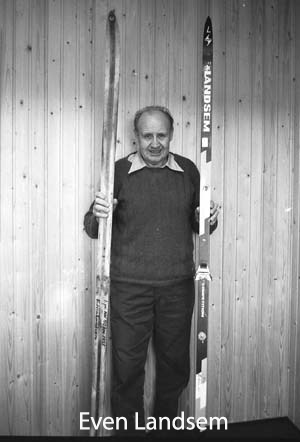 I can thank Odd Erik Heggem for getting me work at the ski factory. He had always permenant work there, while was unemployed at home. Odd Erik tipped me off that Even Landsem had use for workers at the factory and he asked me if I was interested. There I was and Odd Erik mentioned my name to Even. Odd kept his word and talked quite good about me. On November 21, Even Landsem called me and asked me if I wanted to come down to the factory for a tour and talk to him for a little bit. The next day was a Friday, with really icy and slippery roads down over Romundstadbygda. But I drove down and talked to Even and we had a chat. A pretty short chat, I was promised a job - my first permanent job!
I can thank Odd Erik Heggem for getting me work at the ski factory. He had always permenant work there, while was unemployed at home. Odd Erik tipped me off that Even Landsem had use for workers at the factory and he asked me if I was interested. There I was and Odd Erik mentioned my name to Even. Odd kept his word and talked quite good about me. On November 21, Even Landsem called me and asked me if I wanted to come down to the factory for a tour and talk to him for a little bit. The next day was a Friday, with really icy and slippery roads down over Romundstadbygda. But I drove down and talked to Even and we had a chat. A pretty short chat, I was promised a job - my first permanent job!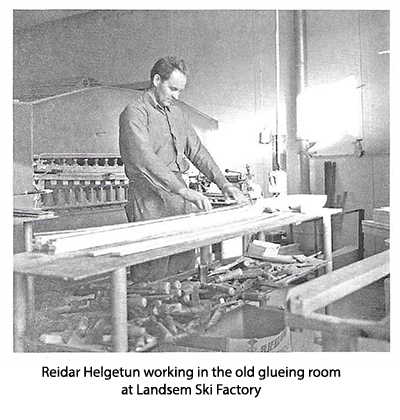 Olaf Røen worked mostly with gluing, and the same was the case
with Ola Honnstad. Reidar Helgetun was a regular worker in the glue room, and always worked in the afternoon and evening. He was engaged in farming, in addition to the work at the factory. East in the raw material warehouse, Ola Romundstad was manager. Reidar stacked materials and brought them into the drying room.
Olaf Røen worked mostly with gluing, and the same was the case
with Ola Honnstad. Reidar Helgetun was a regular worker in the glue room, and always worked in the afternoon and evening. He was engaged in farming, in addition to the work at the factory. East in the raw material warehouse, Ola Romundstad was manager. Reidar stacked materials and brought them into the drying room. The top cap was for the most part made of birch, with two small slats of inlaid red beech. Reason for that, I do not know, but maybe these two slats with beech stabilized the ski sideways?
The top cap was for the most part made of birch, with two small slats of inlaid red beech. Reason for that, I do not know, but maybe these two slats with beech stabilized the ski sideways? 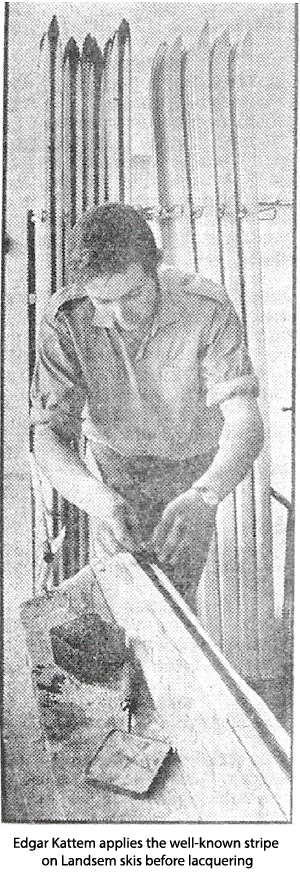 So then the skis came out to the handwork room, where Odd Erik and I worked together for a long time. The first operation there was to paint the groove on the side of the ski. First we had to scrape and smooth the groove, which was a lot of work for a decorative color! Then we painted the famous stripe on the top of the ski. We did it the old fashioned way with a sponge on the end of a wooden stick. It was my task to lay down this colored stripe.
So then the skis came out to the handwork room, where Odd Erik and I worked together for a long time. The first operation there was to paint the groove on the side of the ski. First we had to scrape and smooth the groove, which was a lot of work for a decorative color! Then we painted the famous stripe on the top of the ski. We did it the old fashioned way with a sponge on the end of a wooden stick. It was my task to lay down this colored stripe.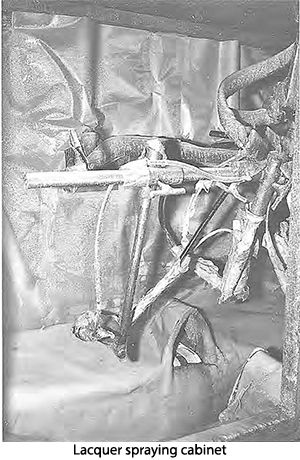 But this spraying machine gave us a lot of work of a rather questionable nature. The air pressure was rather bad, and there were spray guns that were mounted inside a metal cabinet, which left a lot of lacquer on the walls inside. At regular intervals, you have to do proper cleaning to remove the lacquer that had got stuck. We had to crawl into the cabinet to do cleaning. We probably changed that job a bit, but I think that it was I who had the most working hours inside of that lacquer spraying cabinet.
But this spraying machine gave us a lot of work of a rather questionable nature. The air pressure was rather bad, and there were spray guns that were mounted inside a metal cabinet, which left a lot of lacquer on the walls inside. At regular intervals, you have to do proper cleaning to remove the lacquer that had got stuck. We had to crawl into the cabinet to do cleaning. We probably changed that job a bit, but I think that it was I who had the most working hours inside of that lacquer spraying cabinet. 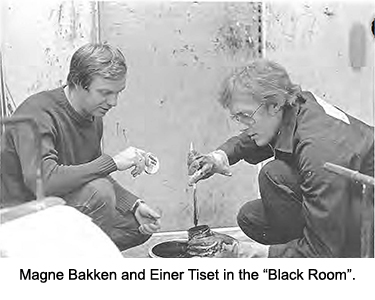 We had begun to apply a plastic coating on the bottom of the ski to get better glide. This was quite bad work. It smelled aweful and and the tough plastic material stuck to everything where it dripped on. First it was applied manually with a brush and roller then a machine applied it, when it worked. It was Einar Tiset's task to apply this black coating on both the sole and the sides of the ski. They performed that task in what we called "the black room".
We had begun to apply a plastic coating on the bottom of the ski to get better glide. This was quite bad work. It smelled aweful and and the tough plastic material stuck to everything where it dripped on. First it was applied manually with a brush and roller then a machine applied it, when it worked. It was Einar Tiset's task to apply this black coating on both the sole and the sides of the ski. They performed that task in what we called "the black room".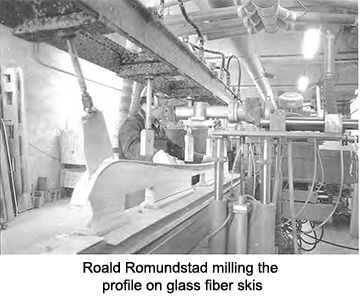 Big changes also happened with production equipment. On January 10, a new milling machine was shipped in and it was test run for the first time on January 21. And already eight days later, Odd Bøset injured himself on the new machine. He set his hand down on one of the cutters on the machine. It was a hospital visit in haste for Odd. Odd's hand reacted quickly in those conditions and it could have been worse.
Big changes also happened with production equipment. On January 10, a new milling machine was shipped in and it was test run for the first time on January 21. And already eight days later, Odd Bøset injured himself on the new machine. He set his hand down on one of the cutters on the machine. It was a hospital visit in haste for Odd. Odd's hand reacted quickly in those conditions and it could have been worse. 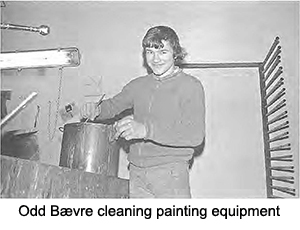 Over the year of 1974, changes came close together. A new glue press was installed on June 26, which was designed for fiberglass skis. There was cooling on the press, so skis could be cooled after gluing. On August 30, a new lacquer/fiber machine was installed in the paint room. And here in this room, by this machine, I was to get my workplace for the next five years or so.
Over the year of 1974, changes came close together. A new glue press was installed on June 26, which was designed for fiberglass skis. There was cooling on the press, so skis could be cooled after gluing. On August 30, a new lacquer/fiber machine was installed in the paint room. And here in this room, by this machine, I was to get my workplace for the next five years or so.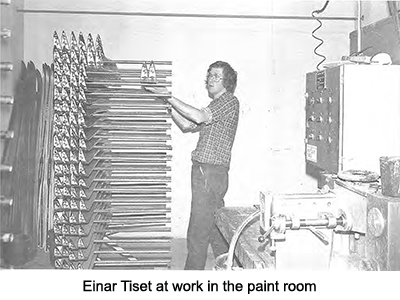 After the Christmas season in 1979, Arild Sæther quit working at the factory. There was a big hole in the work environment after Arild quit. He was one of my best workmates. It was probably at this time that Landsem-ski had its busiest period, with about 60 employees, which it probably had most of the time. But towards the end of 1979, I personally noticed that I had received enough of all the years of working with paints and solvents. I had coughing, cold sweats, and was short of breath. In my free time at home, I had long episodes on the couch and slept. I was really lethargic and in bad in shape. I complained my distress to my employer, and from then on I was largely exempt from work that came in contact with lacquers and solvents.
After the Christmas season in 1979, Arild Sæther quit working at the factory. There was a big hole in the work environment after Arild quit. He was one of my best workmates. It was probably at this time that Landsem-ski had its busiest period, with about 60 employees, which it probably had most of the time. But towards the end of 1979, I personally noticed that I had received enough of all the years of working with paints and solvents. I had coughing, cold sweats, and was short of breath. In my free time at home, I had long episodes on the couch and slept. I was really lethargic and in bad in shape. I complained my distress to my employer, and from then on I was largely exempt from work that came in contact with lacquers and solvents.